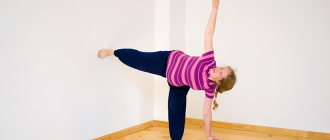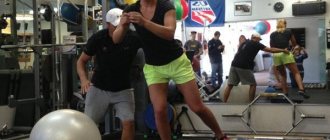Pregnant women always have to deal with endless do’s and don’ts, do’s and don’ts and other advice and thoughts from others. Of course, during the entire period of waiting for the baby, it makes sense to trust, first of all, the advice of professionals. And they insist that the expectant mother needs to start leading a healthy lifestyle as early as possible. It includes proper rest, absence of bad habits, proper nutrition, and moderate physical activity, which helps to easily overcome the entire period and give birth to a healthy baby. Exercising for pregnant women is a great way to improve the condition of the body, tone it up and lift your spirits. But you need to figure out what kind of physical activity the expectant mother should have, and to whom it may be contraindicated.
Why do you need exercises during pregnancy in the 1st trimester?
Thanks to reasonable physical activity throughout pregnancy, the expectant mother is guaranteed:
- easier pregnancy and childbirth compared to sedentary pregnant women;
- minimizing feelings of chronic fatigue and joylessness of life due to the fact that any physical activity is directly related to the production of hormones of happiness and joy;
- reduction in the manifestations of toxicosis or its complete disappearance;
- reducing the risk of oxygen starvation (hypoxia) in the baby, since during well-organized physical activity the pregnant woman’s blood is saturated with oxygen;
- return to prenatal shape in the shortest possible time after the birth of the child.
However, there are a number of persistent stereotypes and misconceptions about exercise during pregnancy in society.
Myth 1. In the first trimester, any sports training is absolutely contraindicated for a pregnant woman.
This is wrong. In the absence of contraindications, physical exercise in the 1st trimester is useful, as it prepares the pregnant woman’s body for upcoming serious stress, trains her heart and lungs, and maintains the necessary muscle tone.
Doctors and fitness instructors unanimously claim that the positive effect of sports during pregnancy is more pronounced the earlier it was started.
Myth 2. At the very beginning of pregnancy, while the belly is not yet visible, you don’t have to limit yourself in sports.
The belly, of course, has not yet rounded, but the woman is already pregnant. This means that she is responsible for the life that has arisen in her. Therefore, any physical activity in the 1st trimester of pregnancy should be agreed with your doctor. In any case, you will most likely have to give up professional sports during pregnancy and completely eliminate traumatic, strength exercises, abdominal exercises, and cardio exercises.
Myth 3. Yoga and stretching exercises are ideal for pregnant women.
There are a huge number of types of yoga, as well as types of stretching exercises. Among them there are indeed special complexes for women in an “interesting” position, which can be performed already from the first trimester of pregnancy. But most ordinary yoga asanas are contraindicated for pregnant women, as are many stretching exercises: they can lead to injury to the pregnant woman and the threat of miscarriage. So you should be more careful when selecting exercises, and it is better to be guided by the opinion of the instructor or coach
Myth 4. The more exercise, the better.
The ideal is to perform a daily set of exercises that include breathing exercises, light stretching exercises and physical therapy. But for women who did not engage in sports before pregnancy, it will be enough to exercise every other day for half an hour, and the optimal types of physical activity for them will be daily walking and swimming.
Breathing exercises at any time
Throughout your pregnancy, you can constantly pamper yourself. Rest more and worry less about trifles. To make it even easier to relax, it is recommended to regularly perform breathing exercises. They are not only remarkably relaxing, but also reduce pain.
Doing breathing exercises is very simple, the main thing is to concentrate and try not to think about anything:
- You need to put one hand on your chest, the other on your stomach, take a deep breath through your nose, then exhale. As you inhale, you need to make sure that your stomach rises and your chest remains in place;
- Hands should be placed on the ribs, elbows spread to the sides. During breathing, the stomach and chest remain motionless, and the elbows slide to the sides;
- One hand on the stomach, the other on the chest. Inhale - the chest rises, the stomach is motionless, exhale.
It is necessary to perform the exercises without holding your breath, as this can harm the baby by causing hypoxia. You should breathe in this way for 30-40 minutes daily.
Contraindications to exercise in the 1st trimester of pregnancy
- any infectious diseases and inflammatory processes in the body;
- increased body temperature over 37 degrees;
- chronic kidney and heart diseases;
- severe toxicosis requiring hospital treatment;
- severe anemia (low hemoglobin level);
- multiple pregnancy;
- threat of miscarriage;
- history of miscarriages or missed abortions;
- uterine bleeding;
- pain in the lower abdomen of any intensity.
Exercises for pregnant women: its meaning
Unfortunately, not all representatives of the fair sex in this position understand the importance of physical exercise and not all do it. Some people don’t want to do exercises, while others are simply afraid of harming the baby and don’t know what kind of exercises can be done during pregnancy.
It is worth noting that physical activity has a positive effect on the muscles of the body. Thanks to it, you can keep yourself in shape, not gain excess weight, and prevent the formation of stretch marks. Breathing is trained during physical exercise. This makes a big difference. Thanks to proper breathing, childbirth will be easier, and the likelihood of asphyxia in the baby will be reduced to zero.
Physical exercise also affects your psychological state. A woman who performs them daily feels a surge of strength and vigor. Exercises for pregnant women give energy and good mood for the whole day.
But not all pregnant women are allowed to bear weight. You will have to refuse physical exercise if there are any contraindications. To avoid harming yourself and your baby, you should definitely visit a doctor and discuss this issue with him.
When is it not advisable for pregnant women to do exercises?
A woman should not exercise if:
- there is toxicosis, and it is accompanied by vomiting;
- I had a miscarriage during my last pregnancy;
- the uterus is in good shape;
- gestosis is observed in the second half of pregnancy;
- the placenta is too low;
- have any diseases (for example, ARVI, gastritis, diabetes);
- abdominal pain occurs.
If morning exercises for pregnant women cause discomfort, then it should be stopped. Thus, when choosing a set of exercises, the expectant mother should not only listen to the recommendations of medical specialists and instructors, but also listen to her body.
What physical exercises can you do during pregnancy?
It is best if the physical activity of a pregnant woman in the 1st trimester includes:
- Daily walks in the fresh air at a calm pace for at least half an hour.
- Swimming in the pool several times a week, and if possible, doing water aerobics.
- If you feel well and have no contraindications, dancing classes (especially oriental belly dancing for pregnant women) and Pilates under the supervision of an instructor are recommended.
- Daily breathing exercises.
- Fitball exercises.
- Sets of stretching exercises to strengthen the muscles of the back, pelvis, legs, and chest.
How to conduct a lesson correctly
The key to success is regularity! If you decide to exercise, then you need to do it on a schedule and try not to miss “training” without a good reason. Ideally, classes should take place every day at the same time. If a woman practices at home, this is easy to do. If you have the desire and means to go to the gym, then this should also be regularly - 2 or 3 times a week. By the way, when the complex is well mastered, on the remaining days you can repeat it at home yourself.
The optimal time is the first half of the day, when the body is still full of strength. Gymnastics should take 20–30 minutes. This is enough to load your body, but not to exhaust yourself. After training, a woman should feel pleasantly tired and be in a good mood. You should not exercise on an empty stomach. Optimally - an hour and a half after breakfast. During classes, if you want, you should definitely drink water or green tea.
The room must be ventilated. If the weather permits, the window can be opened wide.
If you travel out of town in the summer, be sure to train outdoors!
It is advisable to remove unnecessary objects away from you that could cause you to trip. It’s great if there is a large mirror in the room to monitor your exercise technique.
You should definitely buy a beautiful mat and comfortable trousers for exercise with a soft elastic band. These little things create the mood and motivate you to practice every day.
Monitor your breathing and pulse. Exercise should not cause shortness of breath, and the heart rate should not rise above 100-110 beats per minute.
If possible, you need to choose a time for classes when the woman is not alone in the apartment.
Of course, training with a trainer in the gym will be effective, because a specialist can change the load depending on the woman’s condition. If finances allow, and you don’t have to travel to the other end of town to get to the gym, great. And if you want to save money, a good option would be, for example, one workout per week in the gym and repeating the complex at home.
How to do exercises correctly for pregnant women
- all exercises are performed at a calm pace, without overload;
- muscle strengthening exercises alternate with relaxation exercises;
- any stress on the abs, exercises such as “bicycle” or “birch tree” are excluded;
- squats and bends are not done completely, but halfway;
- Stretching exercises are done very carefully, because due to the riot of hormones in
- In a pregnant woman’s body, her ligaments and tendons are easily injured;
- strength loads (for example, exercises with dumbbells and on machines) are excluded altogether in the first trimester, in contrast to the 2nd and 3rd trimesters.
Training program
The first round of exercises is performed on the muscles of the frontal thigh:
- Straightening the legs.
- Leg spread.
Second circle for the hamstring muscles:
- Leg bending.
- Reduction of legs.
Third circle, exercises are aimed at the broad dorsal muscles: traction of the upper block behind the head.
The fourth circle is the chest muscles: bringing the arms and legs together while sitting on the simulator.
Fifth circle – exercises for deltoid muscles:
- Seated bench press on a machine.
- Raising your arms to the sides in a sitting position.
The sixth block is aimed at training the biceps and triceps of the arms:
- Straight arm lat pulldown.
- Straightening the arms in a crossover (multifunctional block exercise machine in the form of a vertical frame).
The complex for pregnant women in the gym completely excludes abdominal exercises, exercises with free weights, all kinds of twisting and bending. Focus on exercises performed while sitting, focusing on your back. Don't make sudden movements; performance should increase gradually. Between approaches, pregnant women can take a break.
A workout for pregnant women in the gym should end in the same way as a regular one, that is, with a five-minute cool-down. An excellent option for this is the cardio zone, but the load should be less than during warm-up. Stretching exercises are not performed in an interesting position during the cool-down.
A set of exercises for pregnant women in the 1st trimester
- Position at the beginning of the exercise: standing, legs slightly apart, back straight, arms freely lowered. On the count from 1 to 5, take a deep breath. On the count from 1 to 7, exhale slowly. Repeat 8-10 times.
- Walking in place for 1 minute alternates with walking on your toes for 30 seconds.
- Position at the beginning of the exercise: standing, legs slightly apart, arms straightened to the sides. At the same time, while inhaling, raise your right arm and left leg, and while exhaling, lower them. Avoid sudden movements. Repeat 5 times, alternating arms and legs.
- Half squats with straight arms pulled back – 5 times.
- Position at the beginning of the exercise: standing, legs slightly apart, hands clasped behind your back. As you inhale, bend back slightly, pulling in your buttocks. As you exhale, stand up straight, taking the starting position. Repeat 6-7 times.
- Half bend forward with straightening your arms in front of you – 5 repetitions.
- Position at the beginning of the exercise: standing or sitting with a straight back, hands connected with palms in front of you at chest level. As you inhale, press your palms against each other with force to tighten your chest muscles. As you exhale, relax your arms and chest muscles, without separating your palms. Repeat 7-8 times.
- Position at the beginning of the exercise: sitting on the floor, legs wide apart, hands on the belt. As you exhale, touch the toe of your right foot with your left hand. As you inhale, sit up straight, taking the starting position. The same with the right hand and left leg. Repeat 7-8 times, alternating legs and arms.
- Position at the beginning of the exercise: on all fours, head down. As you exhale, bend at the waist, rounding your back like a cat. Stay in this position for a count of 1 to 3. While inhaling, take the starting position. Repeat 5-7 times.
- Position at the beginning of the exercise: lying on your back, legs bent at the knees, feet resting on the floor. As you exhale, raise your pelvis, resting your feet on the floor, hold in this position for a count from 1 to 3. As you inhale, lower your pelvis, taking the starting position. Repeat 5-7 times.
You can do several exercises on a fitball:
- sit on the ball and do circular rotations with your pelvis in different directions;
- sit on the floor and hold the ball between your legs, then alternately squeeze the ball with your feet with light force, then release the pressure;
- lie on your stomach on the ball, resting your feet on the floor, and ride it from your chest to your lower abdomen (until your stomach stands out).
At the end of the complex, it is recommended to perform a light stretching and relaxation exercise. Sit on your knees, resting your buttocks on your heels. Stretch your arms forward and try to touch your forehead to the floor. Stretch forward slightly and relax. Repeat several times.
Exercise for the third trimester
Exercising for pregnant women in the 3rd trimester is complicated by those who already have an impressively sized tummy that prevents them from performing most exercises. A fitball can help you, with which you can perform very effective exercises to prepare for childbirth.
Exercise with dumbbells for abdominal and back muscles
You need to sit on a fitball, take dumbbells weighing up to 1 kg in your hands, and lower them along your body. Bend your elbows, lifting the dumbbells to armpit level, then slowly lower them to the starting position, without tilting your body. Then bend your elbows, lifting the dumbbells to your shoulders and slowly lowering them. Alternate movements, watching your breathing.
Exercise to strengthen the muscles of the perineum and thighs
Lie on the floor, put one leg on the fitball. Now try to roll the ball, moving your leg to the side and returning it to its original position. You can also move the ball by bending your knee. Repeat the exercise 3-4 times. The same thing is repeated for the second leg.
Chest exercise
Take the fitball in your hands and hold it, stretching them out in front of you. Now try to slowly squeeze it with your palms, and then slowly relax your hands. It is important to ensure that your stomach does not become tense during this exercise. Repeat the exercise 5-10 times.
Exercising for pregnant women in the 3rd trimester at home using a fitball becomes effective and safe. Don't forget to use a bandage to support your tummy. Water aerobics exercises designed specifically for expectant mothers will also be useful. Watch the video of exercises for pregnant women in the 3rd trimester to understand more about its implementation.
Recommendations for pregnant women
There is a common expression that especially well characterizes the need for physical activity during pregnancy: it is better to sit than to lie down; it is better to stand than sit; It's better to walk than to stand.
Moderate and well-organized sports activity during pregnancy in the absence of contraindications has never harmed anyone.
Don't want to do a set of exercises? Swim! Don't want to swim? Do breathing exercises! And this is not yours? Then walk more or dance. Find for yourself that form of physical activity during pregnancy that will be enjoyable for you and beneficial for your body.
- Do not overheat while playing sports - this worsens the condition of the fetus.
- Drink plenty of fluids during exercise to stimulate your metabolism and enhance the removal of toxins from your body.
- Physical activity is best tolerated a couple of hours after eating (optimally after breakfast).
- Do not overdo it! Remember that your shortness of breath is a symptom that your unborn baby is not getting enough oxygen.
- Take into account how you feel and at the slightest sign of pain in the lower abdomen or discomfort, stop doing the exercise and replace it with another one in the future.
- Don't overwork yourself! 15 minutes a day is enough for physical activity in the first trimester of pregnancy.
- Avoid physical activity on days that would be critical if you were not pregnant. According to medical research, it is at this time that the threat of miscarriage increases sharply.
- Do not neglect breathing exercises and relaxation exercises - every pregnant woman needs to master these skills.
Why play sports
You need to exercise during pregnancy.
In the gym, in the pool, in the fitness center. Anywhere where there are courses for pregnant women. No courses - you can go to the park.
Exercises for pregnant women
in the early stages it is:
- reducing the likelihood of ruptures during childbirth;
- relief of the current condition of the pregnant woman through certain exercises;
- oxygen enrichment of the fetus improves (if the mother does not have shortness of breath);
- overall metabolism improves (both for mother and baby);
- nervous stress decreases;
- the body
childbirth more easily - restoration to its previous shape after childbirth will occur faster;
- the likelihood of gaining excess weight during pregnancy is reduced.
Regarding nervous stress. The human body has a simple scheme that works for everyone, without exception: if you are mentally tired - tense up physically, physically tired - switch to mental activity and the tension will subside. Pregnant women are constantly in a state close to hysteria. Physical exercise for pregnant women is vitally and morally necessary.
Important! Why gymnastics is useful for pregnant women in the 2nd trimester
Video
And now you can look at all this more carefully in this video.
All the exercises, at first glance, are easy and simple, but if you do them honestly every (every!) day the recommended number of times, then in 280 days of pregnancy you can greatly strengthen all organs, prepare for childbirth and for further postpartum life, which will be include a lot of things - joy, sleepless nights, snot, tears, and concern for your beauty. And beauty is, first of all, health, and gymnastics will help you a lot with this.
Write, what did you do during pregnancy in terms of physical fitness? Did you like it all? Have you observed the effect of the classes? Did it help during childbirth? We are interested in absolutely everything.
Main conclusions
Pregnancy is not a sentence to stay at home. During this period, you can engage in many sports that will not only do no harm, but will also bring a lot of benefits:
- Exercising allows you to monitor your weight, regulate blood flow, and prevent the development of hypoxia.
- The best types of training during this period: swimming, gymnastics, Pilates and yoga.
- Pregnant women can visit the gym, but strength training should not involve barbells, abdominal exercises, or squats.
- Fitball is the optimal sports equipment for expectant mothers.
Most exercises for pregnant women are gentle and aimed at working on muscle elasticity and mastering breathing techniques. However, even in this case, consultation and recommendations of the supervising doctor are mandatory conditions for training.











